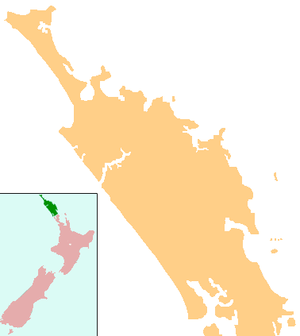Otaika
Otaika (Māori: Ōtaika) is a village 7 km to the south of Whangārei in Northland, New Zealand. The Otaika Stream runs from the north west, through the area, and into the Whangārei Harbour. State Highway 1 runs through the locality. The hill Tikorangi (with a summit 161 m above sea level) lies to the South. Tikorangi is a source of limestone for Portland Cement.[1][2][3]
Otaika | |
|---|---|
 Otaika | |
| Coordinates: 35°47′13″S 174°18′20″E | |
| Country | New Zealand |
| Region | Northland Region |
| District | Whangarei District |
| Population (2018)(includes Portland) | |
| • Total | 1,338 |
The New Zealand Ministry for Culture and Heritage gives a translation of "place of lying in a heap" for Ōtāika.[4]
History
In the 1830s, Okaika was a Māori village of Te Parawhau hapū. Tiakiriri was the chief.[5] The first Pakeha settlers were Frederick and George Taylor, who were living at Otaika by 1856.[3] More Pākehā settled further up the Okaika Valley around this time. George Edge's wandering geese were sometimes eaten by locals, leading to a nickname for the valley of "Kai-goose".[6]
The local Toetoe Marae and Toetoe meeting house, located north of the village on the northern shores of the Otaika Stream, is a tribal meeting ground for the Ngāpuhi hapū of Te Parawhau and Te Uriroroi, and the Ngāti Whātua hapū of Te Uriroroi.[7][8]
Demographics
| Year | Pop. | ±% p.a. |
|---|---|---|
| 2006 | 1,107 | — |
| 2013 | 1,146 | +0.50% |
| 2018 | 1,338 | +3.15% |
| Source: [9] | ||
The statistical area of Otaika-Portland, which also includes Portland, had a population of 1,338 at the 2018 New Zealand census, an increase of 192 people (16.8%) since the 2013 census, and an increase of 231 people (20.9%) since the 2006 census. There were 444 households. There were 687 males and 648 females, giving a sex ratio of 1.06 males per female. Of the total population, 270 people (20.2%) were aged up to 15 years, 228 (17.0%) were 15 to 29, 648 (48.4%) were 30 to 64, and 195 (14.6%) were 65 or older. Figures may not add up to the total due to rounding.
Ethnicities were 83.4% European/Pākehā, 30.5% Māori, 3.8% Pacific peoples, 2.0% Asian, and 1.6% other ethnicities. People may identify with more than one ethnicity.
The percentage of people born overseas was 11.2, compared with 27.1% nationally.
Although some people objected to giving their religion, 58.1% had no religion, 27.4% were Christian, and 4.5% had other religions.
Of those at least 15 years old, 138 (12.9%) people had a bachelor or higher degree, and 234 (21.9%) people had no formal qualifications. The median income was $31,200. The employment status of those at least 15 was that 570 (53.4%) people were employed full-time, 159 (14.9%) were part-time, and 36 (3.4%) were unemployed.[9]
Education
Otaika Valley School is a coeducational contributing primary (years 1-6) school with a roll of 138 students as of March 2020.[10][11]
References
- Peter Dowling (editor) (2004). Reed New Zealand Atlas. Reed Books. pp. map 7. ISBN 0-7900-0952-8.CS1 maint: extra text: authors list (link)
- Roger Smith, GeographX (2005). The Geographic Atlas of New Zealand. Robbie Burton. pp. map 27. ISBN 1-877333-20-4.
- Pickmere, Nancy Preece (1986). Whangarei: The Founding Years. p. 65.
- "1000 Māori place names". New Zealand Ministry for Culture and Heritage. 6 August 2019.
- Pickmere, p 14
- Pickmere, pp 65-66
- "Te Kāhui Māngai directory". tkm.govt.nz. Te Puni Kōkiri.
- "Māori Maps". maorimaps.com. Te Potiki National Trust.
- "Statistical area 1 dataset for 2018 Census". Statistics New Zealand. March 2020. Otaika-Portland (107700). 2018 Census place summary: Otaika-Portland
- "New Zealand Schools Directory". New Zealand Ministry of Education. Retrieved 26 April 2020.
- Education Counts: Otaika Valley School